Ten years had passed since our last visit
to the African rainforest. At that time, my father and I hunted the eastern
part of the Shanga River in the Central African Republic. It was time to go back
and experience one of the most amazing hunts you can have in Africa.
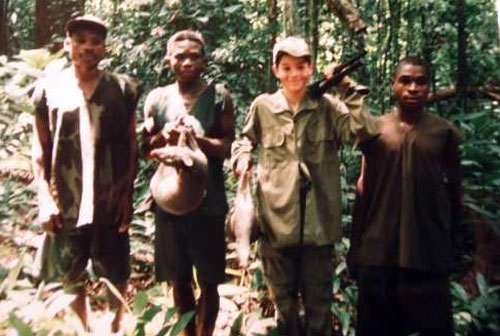
This time we were going to Cameroon, close
to the Ngoko River which borders the Congo. We had planned a 13 day hunt with
Jose Chelet (nicknamed Pepe) from Chelet Hunting Safaris, an outstanding guide
and a good friend from Spain.
The most important part of this trip was
the time spent with my father. I feel really lucky to be able to share these
hunts with a father who has taught me everything I know and whose passion for
hunting is immeasurable. He is, without a doubt, the best hunting partner you
can have.
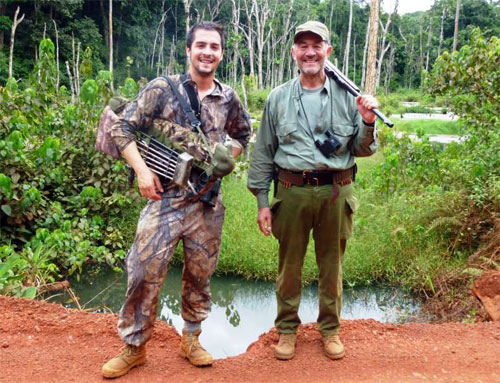
My father’s objective for this hunt was the
elusive Dwarf Forest Buffalo, and the amazing Bongo Antelope for myself.
Other animals were on the list too, like the forest Sitaunga, Duikers, bush
pigs and the giant forest hog.
In the rainforest, you may have a target
but you never know what the rainforest will give you. So you should go with an
open mind. Along with the huntable creatures, there is also the chance you
may get to see other non-game animals like the elusive Forest Elephant, Gorillas,
and other exotic species.
THE ADVENTURE BEGINS
If there is something that you have plenty
of in Africa, it is time. The real Africa welcomed us by forcing us to spend
two days waiting on “paperwork” to be done in order to get the charter plane to
fly to our final destination. Finally, we managed to arrive at the hunting area
after many hours since we left Spain. Pepe was waiting for us at a little timber
landing strip.
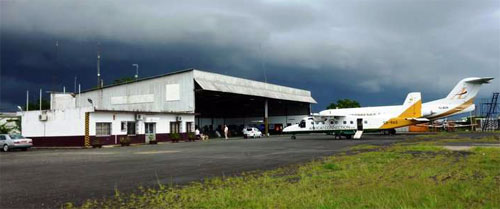
HUNTING METHOD
The rainforest is overwhelming; everything
is so immense, so dense and so wild that just having the opportunity to spend
some days there makes the long trip worthwhile. Unfortunately, timber production
has hit this forest hard in the last few years. Tons of Millenarian trees have been
removed from the area, breaking the forest into a maze of timber trails.
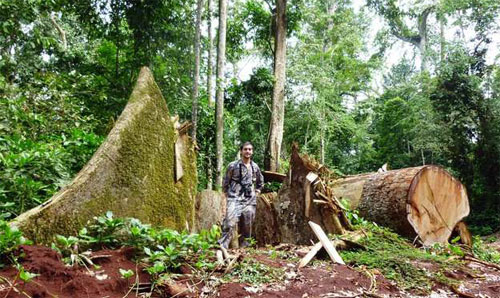
The cutting of these big trees allows the
light to penetrate the forest floor, and the effect of the sun’s rays on such
fertile land results in an impenetrable understory that can only be explored by
the slash of the machete.
Luckily for us, we were hunting with
probably the best hunters in the world, the Baka Pigmies. Their level of skill is
so high, and the difference with other hunters so overwhelming that it is impossible
not to succumb to absolute admiration for these small, yet great woodsmen. It
is just unbelievable how they read the forest. You think that you have seen it
all until you see them tracking a Sitatunga under the water! Simply ridiculous.
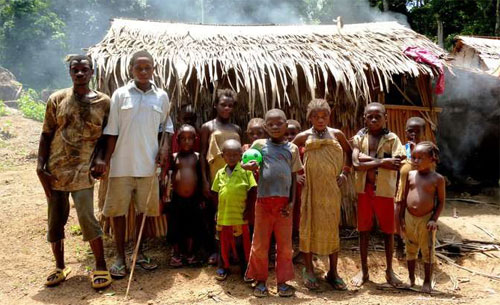
The main hunting method employed in the
rain forest is tracking. You spend the morning slowly looking for fresh tracks
along the timber trails. If you find something worth following, you just go
after it. As the forest is so dense, it is simply impossible to get to the game
without the help of a few little dogs.
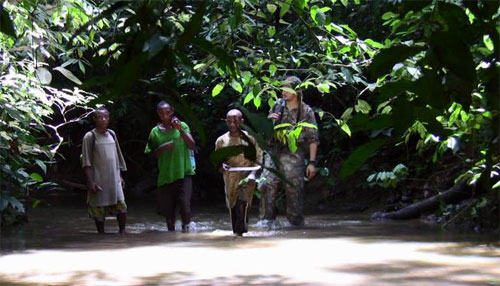
While tracking, they stay close by you and
together with the group. They know how easily they can get lost. After a few hours
of tracking, when you put up an animal, they go after it, and with a bit of
luck they are able to stop it for a few moments -typically in the thickest part
of the forest. Here the animals make a stand and face the dogs, looking for a
fight. The bongo and the buffalo both end up kicking some of the dogs in the
process.
So with this background, you have enough
information to understand what happened to us on one of the first days of
hunting. While looking for a fresh bongo track, we found one that looked like a
good one. Soon we discovered that it was a really fresh one, and when I mean really
fresh, I mean that there was a little puddle in the way where the water was
still moving!
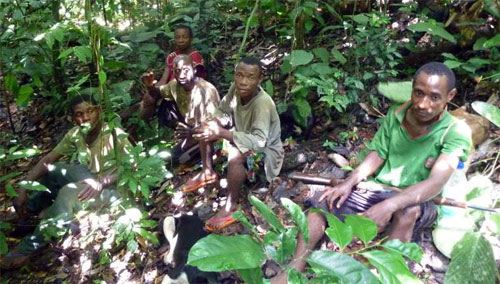
We did not have to wait long until the
bongo jumped in front of us. After a few tense seconds, the dogs started
barking and we were running like crazy. Even with such an amount of adrenalin
in your blood, you lose all inhibitions and we were able to go through places
we would never think of. In the last few meters of the chase, the run turned
in to a smooth stalk, as we could hear the bongo running the dogs, but we could
not see more than ten meters in front of us.
We were all behind a big tree with the
bongo just five meters away running the dogs, but we still could not see it!
After just a glimpse of the bongo between the bush, and considering the
situation, we decided to back up. It would have been impossible to get an arrow
through there. One of the main problems we realized at that moment was that everywhere
you turned was more of the same. Getting an arrow through there would not be
easy.
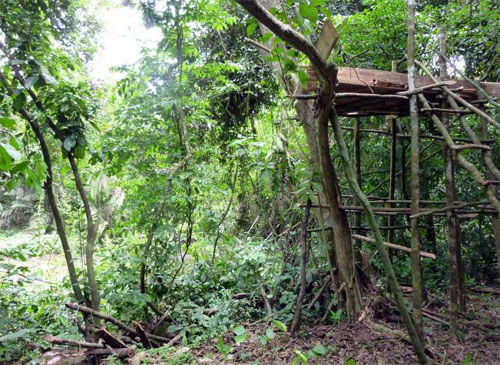
During the afternoons there was not enough
time for tracking game, as night inside the forest comes quickly. For that
reason, every afternoon my father would go to the viewpoints, placed on a few
small openings inside the forest, where I would call for duikers with two of
the pygmies.
GLORIOUS DAY
We had already spent a few days of hard
hunting without luck. We had seen few tracks and followed up on some, but except
for the bongo I described above we had no opportunities. Hunting in the forest is
tough, both physically and psychologically. Lots of hours walking inside the
jungle, all the time bent at the waist or on our knees. Then there’s the high
temperatures and even higher humidity, all which makes hunting exhausting. You
also have the issue of not seeing any game at all, and that can lead you to
think you are looking for ghosts. This is half true because animals can appear
from anywhere and disappear in half a second with ease.
But the 1st of May was different. A
mysterious morning fog was hiding something that we were about to discover.
It was early in the morning when we cut a lone,
fresh, buffalo bull track. The track was from the previous night, so my father
got down to give it a try. With him was his PH, Hancke Hudson while Pepe and I
went to look for a bongo track.
While going through the trails looking for bono
tracks we came across something that we would have never expected. Just 30
meters from the road was a bongo taking a bath! We had it in front of us for
more than five minutes and stayed there, observing it until we decided to leave
it alone with its bath.
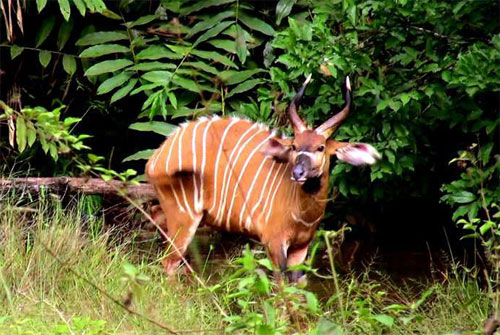
Although we knew we could regret it later,
it was definitively not the way of getting such a majestic animal. It was
probably one of the most beautiful encounters with an animal that I have ever
experienced. What are the chances of seeing a wild bongo bathing for five full
minutes, just thirty meters away? As the pigmies said, it was mother forest’s
way of saying good morning.
As if that had not been enough, we had a
second magical encounter that morning. After a few days of hunting without
seeing any animal, we had not only seen the bongo, but also a gorilla!
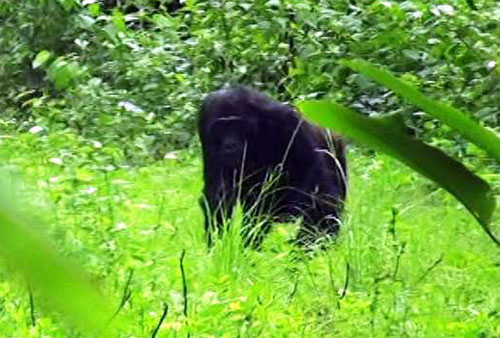
It was not until one o’clock in the
afternoon when we came across a bongo track. Although it was late, we decided
to give it a try. Our goal was to follow it for ninety minutes and if we did
not get to the bongo, we would leave it so we could get to the vehicle before
dark.
The tracking team was formed by Endeke,
Rigobertte, Kema and Martin; all of them exceptional trackers. Each step was
followed as though they were inside the animal’s head and all of them working
together as a team. Every step took us a bit closer to our prey and a moment I
had dreamed of many times before.
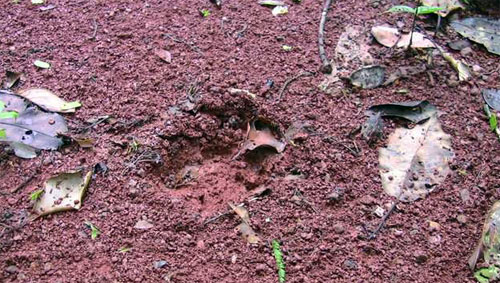
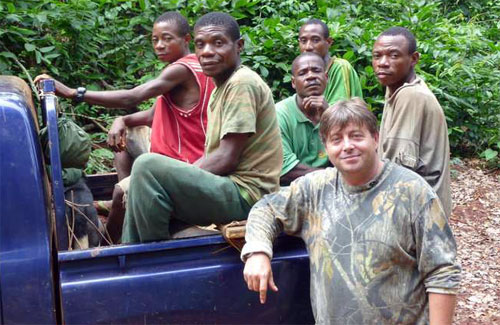
After a little more than an hour, we heard
the bongo jump and was soon followed by the dogs. A few moments later, we heard
them barking; the bongo had stopped to face them. Run!!!!!!!
Flying through the lianas thicket, we were
suddenly stopped by the pigmies. We were very close and now it was our turn to
enter into action; Pepe with the rifle, and me with my bow. We were ahead of
the line, getting closer to the barking and the sound of the bongo’s charges.
Suddenly we saw it, just an orange shadow
only twelve meters away! Looking for a lane with better visibility, we were advancing
a few meters, when a charge of the bongo at the dogs, sent him in our direction
and forced us to jump out of his way. Luckily, Pepe being a very good professional
did not shoot, even though the situation gave us the creeps. It was really,
really close!
The bongo returned to its initial position,
and started fighting the dogs again. It was difficult to get a clear view. In
addition to the dogs running around the animal, the bongo also kept moving trying
to reach them. I needed to find a way to a clear shot.
Pepe kneeled down and was ready to give me
back up, so I decided to gain a few more yards and try to find a hole between the
maze of tree and brush limbs. Suddenly, the bongo ran at a dog and that created
a twelve inch hole. Without hesitation, I drew my bow and released my arrow as
quickly as I could. The shot was just eight meters away!
The arrow found its mark and I could
clearly see the white blazers right behind the shoulder. I moved away from my
position and told tell Pepe to back up. I knew it was a perfect shot and did
not want to force the situation. Amazingly, in ten seconds, the bongo fell
down, much to the astonishment of all of us. Yahooo!!!!!
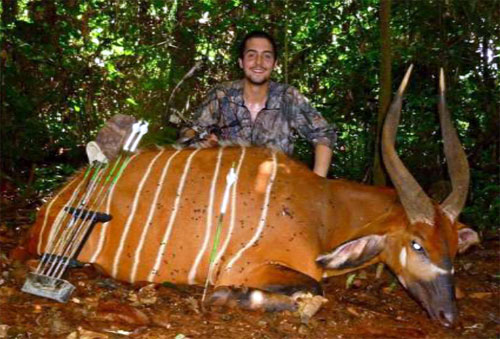
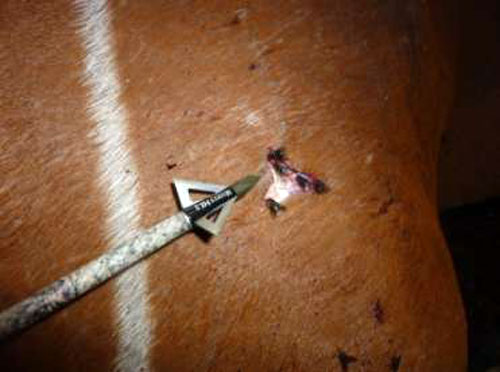
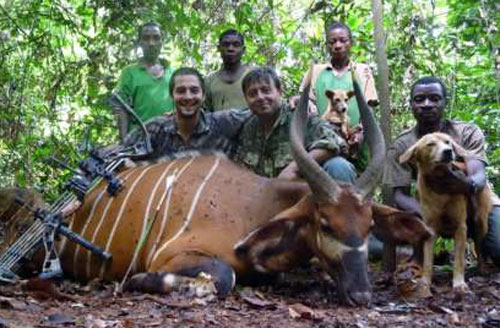
The restrained adrenaline exploded, and we
all started shouting, hugging, and all those things that you do in that kind of
moment. It was a dream come true, and one of the most exciting hunting
experiences I had ever had. I don’t think I could reproduce or explain the
emotion of that moment. It was in one word, unique.
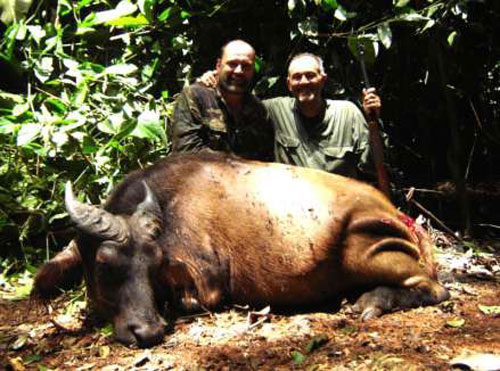
And so as to close the perfect day, my
father was waiting for us in the camp with a beautiful buffalo! After following
that morning’s track for over three hours, they jumped the lone buffalo, and
when it was about to start charging, my father put a bullet from his .375 on
its chest to stop it, only twelve yards away! After that initial shot, my
father and Hancke both put a couple more bullets into the buffalo before it
disappeared in the forest. I would have loved to be there. The 1st of May
will always be a special day for us.
FINAL
With the main objectives fulfilled, the
hunt radically changed. We were now going to focus on the Sitatunga and were
hoping for the rainforest to provide us some luck once more. But as always
happens on every adventure, there are ups and downs, and I was put down with a fever
for two days and forced to rest. Thank god it was not malaria. After a couple
days I was back on my feet and able to rejoin the team again with renewed
strength. There
isn’t a better cure for fever than a bit of sitatunga tracking; they simply
love water! And after long tracks, they just vanish without a trace.
That afternoon, my father went as always to
a viewpoint, while I decided to discover the forest with Endeke and Mustik.
Poaching in these areas has been intense; there where snares everywhere and the
most affected animals were the duikers. Years ago, you could easily call in
several duikers at the same time, but this time, we were having problems
bringing even one in. However, the opportunity to learn from the pigmies was
amazing. I spent all the afternoon asking them things, and they taught me to
put snares, to find good water, read forest signals and to track game.
They would make the distress noise, and
duikers would come in to help the partner (I would never understand why, since
there is not much a little duiker can do). After five minutes of calling, we
got up and went further inside the forest for another 15 minutes and started
calling again.
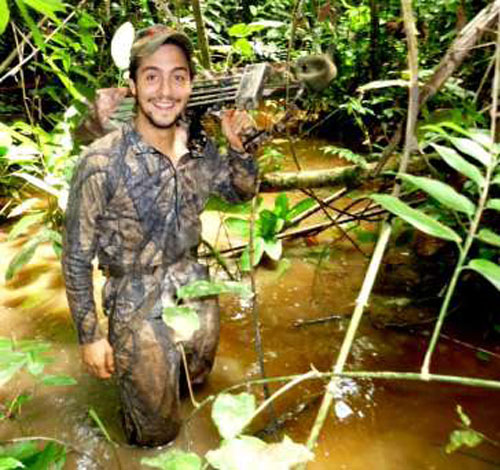
That afternoon nothing came in for the
first five calls, but on the sixth one, and only after five minutes of calling a
Peters Duiker appeared from nowhere at just six meters away.
There it was, looking in our direction to
see what was going on. I drew the bow as slowly as possible, and just as I
reached full draw, released the arrow. There was no time to waste. The arrow
flew, but I had no idea of where it had gone. Everything happened so fast.
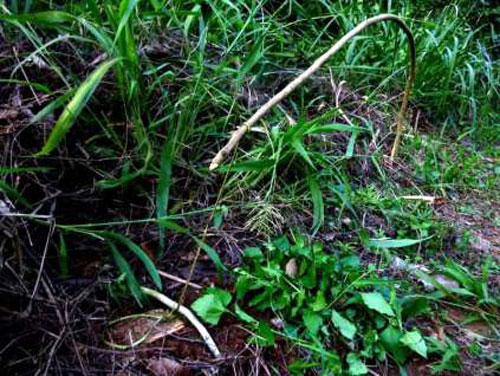
Endeke said that I had missed it. I was
disappointed, as we had been working hard all the afternoon. However, I said I
wanted to see the shot. We started looking for it and there was blood all over
the ground. A perfect missed turned to be a perfect heart shot. We got the Peters
a few meters away from the site of the shot.
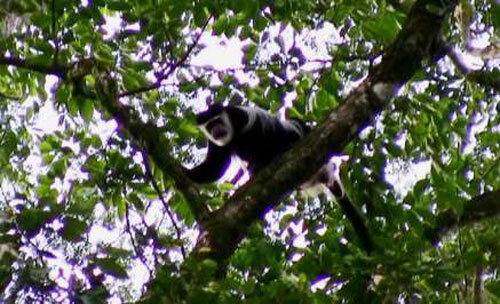
It was an old warrior, it only had three
legs, and on one of them there was a snare. We were in the middle of nowhere,
but there was the duiker with two snares, and my Bongo also had two snares. I do
not know if there is a solution, but if it keeps going like this, the forest
hunting is going to disappear.
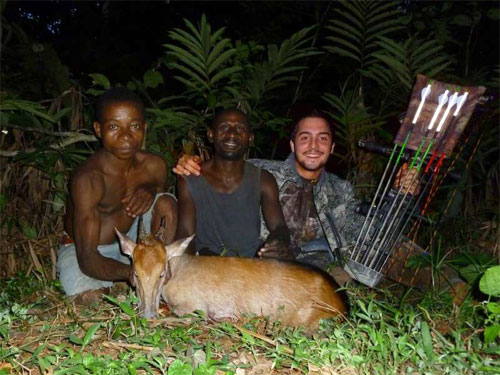
We crossed Sitatunga tracks almost every
day, but getting to them was nearly impossible. We only saw one in the time we
chased them; a fawn on a swamp, but that was it. We were going through some
really dry days, and game movement slowed down so much It was becoming hard to
cross fresh tracks. But finally it rained, and when it rains in the rainforest,
you had better be prepared!
It rained nonstop for a whole day and in
such a way that all the bridges fell down. We had to spend a day rebuilding
them. But the important thing is that everyone was happy!
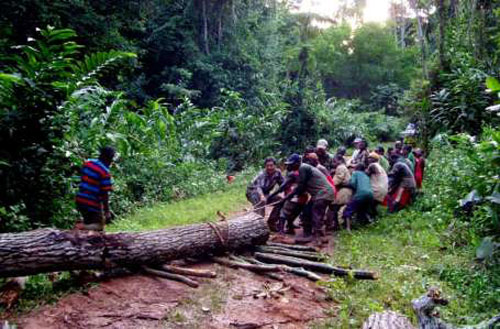
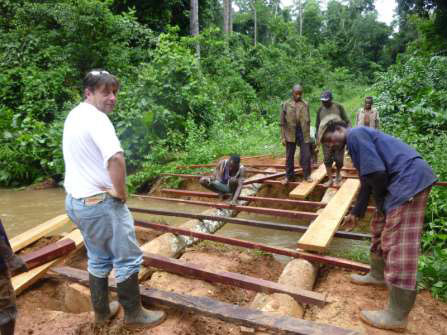
The local people came to help us
reconstruct theroads. But soon after the rain stopped, the animals started
moving again, and that was exactly what we needed. Tons of small critters
showed up, even those we would classify as “pests.” As Hancke used to say,
“They are either going to bite you, sting you or lay eggs on you - or maybe all
three things at the same time!”
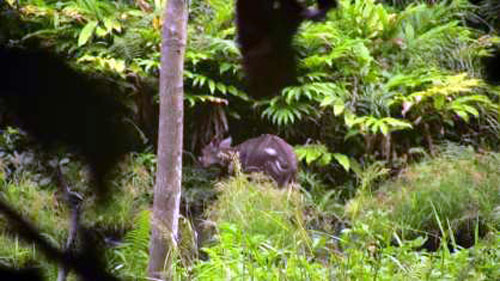
Every day we cut sitatunga tracks, and
until the last moment of the hunt, we tried to find one, but all we managed was
to hear them running. It was the fourth time my father had tried to get one of
these beasts. It is definitely not an easy animal to kill. However, that gives
us the perfect excuse to come back to the rainforest.
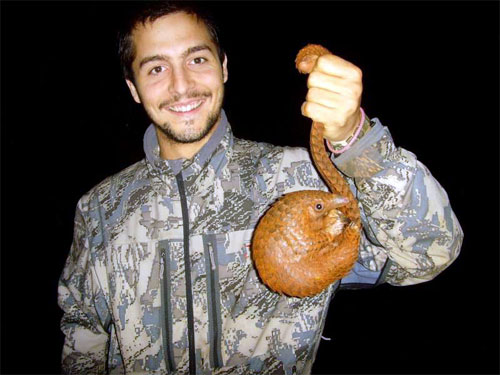
Getting back home was not easy. Again, a “paperwork”
problem made us lose two days waiting for a charter plane that didn’t show up.
We had no other solution than to drive 24 hours straight trough those crazy,
timber roads. All the while trucks driving at full speed with tons of timber
loaded behind.
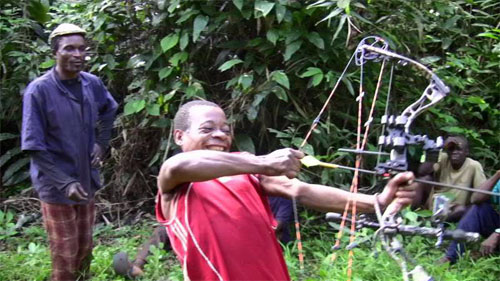
Despite such problems and inconveniences,
nothing could change the flavor of an incredible trip. The main reason why
almost each year, my father and I get into one of these hunts is the adventure.
You know how things start, but you never how they are going to end. We had managed
to spend a wonderful time in one of the wildest places on earth, hunting with outstanding
trackers, for astonishing animals.
Thanks for coming along, Pedro Ampuero